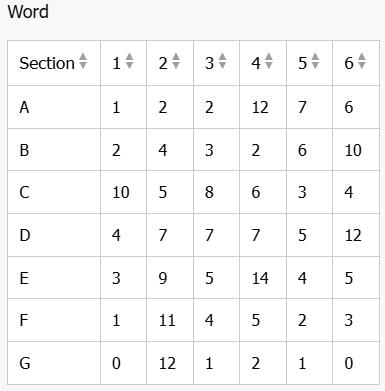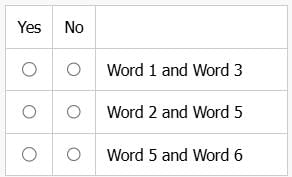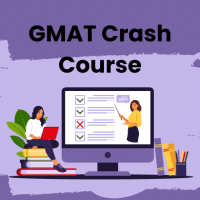GMAT Exam > GMAT Questions > A text written in an unknown language was rec...
Start Learning for Free
A text written in an unknown language was recently discovered and then digitized and analyzed. The analysts divided the text into 7 sections- Sections A through G—and computed word frequencies by section for each word in the text. The table shows these frequencies for Words 1 through 6. For instance, the table shows that Word 1 appeared 1 time in Section A, and 10 times in Section C.
The analysts consider two words to be correlational if their frequencies in the 7 sections of the text were positively correlated.
For each of the following pairs of words, select Yes if the information provided suggests that the analysts would consider the two words correlational. Otherwise, select No.
Frequency of Certain Words, by Section


The analysts consider two words to be correlational if their frequencies in the 7 sections of the text were positively correlated.
For each of the following pairs of words, select Yes if the information provided suggests that the analysts would consider the two words correlational. Otherwise, select No.
Frequency of Certain Words, by Section


- a)Word 1 and Word 3: No
Word 2 and Word 5: No
Word 5 and Word 6: Yes - b)Word 1 and Word 3: Yes
Word 2 and Word 5: No
Word 5 and Word 6: Yes - c)Word 1 and Word 3: No
Word 2 and Word 5: No
Word 5 and Word 6: No - d)Word 1 and Word 3: Yes
Word 2 and Word 5: Yes
Word 5 and Word 6: Yes - e)Word 1 and Word 3: No
Word 2 and Word 5: Yes
Word 5 and Word 6: Yes
Correct answer is option 'B'. Can you explain this answer?
Most Upvoted Answer
A text written in an unknown language was recently discovered and then...
To determine the correct answer, let's analyze the frequencies of the words in the different sections for each of the pairs mentioned in the options. We will check if the frequencies of the words show a positive correlation, meaning as one increases, the other also increases in the same sections.
Pair 1: Word 1 and Word 3
Let's look at the frequencies for Word 1 and Word 3 across all sections:
As we can see, as the frequency of
Word 1
increases (from Section A to Section C), the frequency of
Word 3
also increases in a similar pattern, indicating a positive correlation. Therefore,
Word 1 and Word 3
are
positively correlated
.
Conclusion
:
Yes
(positive correlation)
Pair 2: Word 2 and Word 5
Let’s examine the frequencies for Word 2 and Word 5 across all sections:
As we observe, the frequencies for
Word 2
and
Word 5
do not follow a clear upward or downward trend together. For example, in Section A, Word 2 has a frequency of 2 and Word 5 has a frequency of 7, but in Section G, Word 2 has a frequency of 12 and Word 5 has a frequency of 1. This shows no consistent positive correlation.
Conclusion
:
No
(no positive correlation)
Pair 3: Word 5 and Word 6
Now, let’s look at the frequencies for Word 5 and Word 6 across all sections:
Here, we can see that as the frequency of Word 5 decreases (from Section A to Section G), the frequency of Word 6 also generally decreases in a similar pattern. This indicates a positive correlation between the two words.
Conclusion: Yes (positive correlation)
Final Answer
- Word 1 and Word 3: Yes (positive correlation)
- Word 2 and Word 5: No (no positive correlation)
- Word 5 and Word 6: Yes (positive correlation)
Thus, the correct option is Option B:

|
Explore Courses for GMAT exam
|

|
Question Description
A text written in an unknown language was recently discovered and then digitized and analyzed. The analysts divided the text into 7 sections- Sections A through G—and computed word frequencies by section for each word in the text. The table shows these frequencies for Words 1 through 6. For instance, the table shows that Word 1 appeared 1 time in Section A, and 10 times in Section C.The analysts consider two words to be correlational if their frequencies in the 7 sections of the text were positively correlated.For each of the following pairs of words, select Yes if the information provided suggests that the analysts would consider the two words correlational. Otherwise, select No.Frequency of Certain Words, by Sectiona)Word 1 and Word 3: NoWord 2 and Word 5: NoWord 5 and Word 6: Yesb)Word 1 and Word 3: YesWord 2 and Word 5: NoWord 5 and Word 6: Yesc)Word 1 and Word 3: NoWord 2 and Word 5: NoWord 5 and Word 6: Nod)Word 1 and Word 3: YesWord 2 and Word 5: YesWord 5 and Word 6: Yese)Word 1 and Word 3: NoWord 2 and Word 5: YesWord 5 and Word 6: YesCorrect answer is option 'B'. Can you explain this answer? for GMAT 2025 is part of GMAT preparation. The Question and answers have been prepared according to the GMAT exam syllabus. Information about A text written in an unknown language was recently discovered and then digitized and analyzed. The analysts divided the text into 7 sections- Sections A through G—and computed word frequencies by section for each word in the text. The table shows these frequencies for Words 1 through 6. For instance, the table shows that Word 1 appeared 1 time in Section A, and 10 times in Section C.The analysts consider two words to be correlational if their frequencies in the 7 sections of the text were positively correlated.For each of the following pairs of words, select Yes if the information provided suggests that the analysts would consider the two words correlational. Otherwise, select No.Frequency of Certain Words, by Sectiona)Word 1 and Word 3: NoWord 2 and Word 5: NoWord 5 and Word 6: Yesb)Word 1 and Word 3: YesWord 2 and Word 5: NoWord 5 and Word 6: Yesc)Word 1 and Word 3: NoWord 2 and Word 5: NoWord 5 and Word 6: Nod)Word 1 and Word 3: YesWord 2 and Word 5: YesWord 5 and Word 6: Yese)Word 1 and Word 3: NoWord 2 and Word 5: YesWord 5 and Word 6: YesCorrect answer is option 'B'. Can you explain this answer? covers all topics & solutions for GMAT 2025 Exam. Find important definitions, questions, meanings, examples, exercises and tests below for A text written in an unknown language was recently discovered and then digitized and analyzed. The analysts divided the text into 7 sections- Sections A through G—and computed word frequencies by section for each word in the text. The table shows these frequencies for Words 1 through 6. For instance, the table shows that Word 1 appeared 1 time in Section A, and 10 times in Section C.The analysts consider two words to be correlational if their frequencies in the 7 sections of the text were positively correlated.For each of the following pairs of words, select Yes if the information provided suggests that the analysts would consider the two words correlational. Otherwise, select No.Frequency of Certain Words, by Sectiona)Word 1 and Word 3: NoWord 2 and Word 5: NoWord 5 and Word 6: Yesb)Word 1 and Word 3: YesWord 2 and Word 5: NoWord 5 and Word 6: Yesc)Word 1 and Word 3: NoWord 2 and Word 5: NoWord 5 and Word 6: Nod)Word 1 and Word 3: YesWord 2 and Word 5: YesWord 5 and Word 6: Yese)Word 1 and Word 3: NoWord 2 and Word 5: YesWord 5 and Word 6: YesCorrect answer is option 'B'. Can you explain this answer?.
A text written in an unknown language was recently discovered and then digitized and analyzed. The analysts divided the text into 7 sections- Sections A through G—and computed word frequencies by section for each word in the text. The table shows these frequencies for Words 1 through 6. For instance, the table shows that Word 1 appeared 1 time in Section A, and 10 times in Section C.The analysts consider two words to be correlational if their frequencies in the 7 sections of the text were positively correlated.For each of the following pairs of words, select Yes if the information provided suggests that the analysts would consider the two words correlational. Otherwise, select No.Frequency of Certain Words, by Sectiona)Word 1 and Word 3: NoWord 2 and Word 5: NoWord 5 and Word 6: Yesb)Word 1 and Word 3: YesWord 2 and Word 5: NoWord 5 and Word 6: Yesc)Word 1 and Word 3: NoWord 2 and Word 5: NoWord 5 and Word 6: Nod)Word 1 and Word 3: YesWord 2 and Word 5: YesWord 5 and Word 6: Yese)Word 1 and Word 3: NoWord 2 and Word 5: YesWord 5 and Word 6: YesCorrect answer is option 'B'. Can you explain this answer? for GMAT 2025 is part of GMAT preparation. The Question and answers have been prepared according to the GMAT exam syllabus. Information about A text written in an unknown language was recently discovered and then digitized and analyzed. The analysts divided the text into 7 sections- Sections A through G—and computed word frequencies by section for each word in the text. The table shows these frequencies for Words 1 through 6. For instance, the table shows that Word 1 appeared 1 time in Section A, and 10 times in Section C.The analysts consider two words to be correlational if their frequencies in the 7 sections of the text were positively correlated.For each of the following pairs of words, select Yes if the information provided suggests that the analysts would consider the two words correlational. Otherwise, select No.Frequency of Certain Words, by Sectiona)Word 1 and Word 3: NoWord 2 and Word 5: NoWord 5 and Word 6: Yesb)Word 1 and Word 3: YesWord 2 and Word 5: NoWord 5 and Word 6: Yesc)Word 1 and Word 3: NoWord 2 and Word 5: NoWord 5 and Word 6: Nod)Word 1 and Word 3: YesWord 2 and Word 5: YesWord 5 and Word 6: Yese)Word 1 and Word 3: NoWord 2 and Word 5: YesWord 5 and Word 6: YesCorrect answer is option 'B'. Can you explain this answer? covers all topics & solutions for GMAT 2025 Exam. Find important definitions, questions, meanings, examples, exercises and tests below for A text written in an unknown language was recently discovered and then digitized and analyzed. The analysts divided the text into 7 sections- Sections A through G—and computed word frequencies by section for each word in the text. The table shows these frequencies for Words 1 through 6. For instance, the table shows that Word 1 appeared 1 time in Section A, and 10 times in Section C.The analysts consider two words to be correlational if their frequencies in the 7 sections of the text were positively correlated.For each of the following pairs of words, select Yes if the information provided suggests that the analysts would consider the two words correlational. Otherwise, select No.Frequency of Certain Words, by Sectiona)Word 1 and Word 3: NoWord 2 and Word 5: NoWord 5 and Word 6: Yesb)Word 1 and Word 3: YesWord 2 and Word 5: NoWord 5 and Word 6: Yesc)Word 1 and Word 3: NoWord 2 and Word 5: NoWord 5 and Word 6: Nod)Word 1 and Word 3: YesWord 2 and Word 5: YesWord 5 and Word 6: Yese)Word 1 and Word 3: NoWord 2 and Word 5: YesWord 5 and Word 6: YesCorrect answer is option 'B'. Can you explain this answer?.
Solutions for A text written in an unknown language was recently discovered and then digitized and analyzed. The analysts divided the text into 7 sections- Sections A through G—and computed word frequencies by section for each word in the text. The table shows these frequencies for Words 1 through 6. For instance, the table shows that Word 1 appeared 1 time in Section A, and 10 times in Section C.The analysts consider two words to be correlational if their frequencies in the 7 sections of the text were positively correlated.For each of the following pairs of words, select Yes if the information provided suggests that the analysts would consider the two words correlational. Otherwise, select No.Frequency of Certain Words, by Sectiona)Word 1 and Word 3: NoWord 2 and Word 5: NoWord 5 and Word 6: Yesb)Word 1 and Word 3: YesWord 2 and Word 5: NoWord 5 and Word 6: Yesc)Word 1 and Word 3: NoWord 2 and Word 5: NoWord 5 and Word 6: Nod)Word 1 and Word 3: YesWord 2 and Word 5: YesWord 5 and Word 6: Yese)Word 1 and Word 3: NoWord 2 and Word 5: YesWord 5 and Word 6: YesCorrect answer is option 'B'. Can you explain this answer? in English & in Hindi are available as part of our courses for GMAT.
Download more important topics, notes, lectures and mock test series for GMAT Exam by signing up for free.
Here you can find the meaning of A text written in an unknown language was recently discovered and then digitized and analyzed. The analysts divided the text into 7 sections- Sections A through G—and computed word frequencies by section for each word in the text. The table shows these frequencies for Words 1 through 6. For instance, the table shows that Word 1 appeared 1 time in Section A, and 10 times in Section C.The analysts consider two words to be correlational if their frequencies in the 7 sections of the text were positively correlated.For each of the following pairs of words, select Yes if the information provided suggests that the analysts would consider the two words correlational. Otherwise, select No.Frequency of Certain Words, by Sectiona)Word 1 and Word 3: NoWord 2 and Word 5: NoWord 5 and Word 6: Yesb)Word 1 and Word 3: YesWord 2 and Word 5: NoWord 5 and Word 6: Yesc)Word 1 and Word 3: NoWord 2 and Word 5: NoWord 5 and Word 6: Nod)Word 1 and Word 3: YesWord 2 and Word 5: YesWord 5 and Word 6: Yese)Word 1 and Word 3: NoWord 2 and Word 5: YesWord 5 and Word 6: YesCorrect answer is option 'B'. Can you explain this answer? defined & explained in the simplest way possible. Besides giving the explanation of
A text written in an unknown language was recently discovered and then digitized and analyzed. The analysts divided the text into 7 sections- Sections A through G—and computed word frequencies by section for each word in the text. The table shows these frequencies for Words 1 through 6. For instance, the table shows that Word 1 appeared 1 time in Section A, and 10 times in Section C.The analysts consider two words to be correlational if their frequencies in the 7 sections of the text were positively correlated.For each of the following pairs of words, select Yes if the information provided suggests that the analysts would consider the two words correlational. Otherwise, select No.Frequency of Certain Words, by Sectiona)Word 1 and Word 3: NoWord 2 and Word 5: NoWord 5 and Word 6: Yesb)Word 1 and Word 3: YesWord 2 and Word 5: NoWord 5 and Word 6: Yesc)Word 1 and Word 3: NoWord 2 and Word 5: NoWord 5 and Word 6: Nod)Word 1 and Word 3: YesWord 2 and Word 5: YesWord 5 and Word 6: Yese)Word 1 and Word 3: NoWord 2 and Word 5: YesWord 5 and Word 6: YesCorrect answer is option 'B'. Can you explain this answer?, a detailed solution for A text written in an unknown language was recently discovered and then digitized and analyzed. The analysts divided the text into 7 sections- Sections A through G—and computed word frequencies by section for each word in the text. The table shows these frequencies for Words 1 through 6. For instance, the table shows that Word 1 appeared 1 time in Section A, and 10 times in Section C.The analysts consider two words to be correlational if their frequencies in the 7 sections of the text were positively correlated.For each of the following pairs of words, select Yes if the information provided suggests that the analysts would consider the two words correlational. Otherwise, select No.Frequency of Certain Words, by Sectiona)Word 1 and Word 3: NoWord 2 and Word 5: NoWord 5 and Word 6: Yesb)Word 1 and Word 3: YesWord 2 and Word 5: NoWord 5 and Word 6: Yesc)Word 1 and Word 3: NoWord 2 and Word 5: NoWord 5 and Word 6: Nod)Word 1 and Word 3: YesWord 2 and Word 5: YesWord 5 and Word 6: Yese)Word 1 and Word 3: NoWord 2 and Word 5: YesWord 5 and Word 6: YesCorrect answer is option 'B'. Can you explain this answer? has been provided alongside types of A text written in an unknown language was recently discovered and then digitized and analyzed. The analysts divided the text into 7 sections- Sections A through G—and computed word frequencies by section for each word in the text. The table shows these frequencies for Words 1 through 6. For instance, the table shows that Word 1 appeared 1 time in Section A, and 10 times in Section C.The analysts consider two words to be correlational if their frequencies in the 7 sections of the text were positively correlated.For each of the following pairs of words, select Yes if the information provided suggests that the analysts would consider the two words correlational. Otherwise, select No.Frequency of Certain Words, by Sectiona)Word 1 and Word 3: NoWord 2 and Word 5: NoWord 5 and Word 6: Yesb)Word 1 and Word 3: YesWord 2 and Word 5: NoWord 5 and Word 6: Yesc)Word 1 and Word 3: NoWord 2 and Word 5: NoWord 5 and Word 6: Nod)Word 1 and Word 3: YesWord 2 and Word 5: YesWord 5 and Word 6: Yese)Word 1 and Word 3: NoWord 2 and Word 5: YesWord 5 and Word 6: YesCorrect answer is option 'B'. Can you explain this answer? theory, EduRev gives you an
ample number of questions to practice A text written in an unknown language was recently discovered and then digitized and analyzed. The analysts divided the text into 7 sections- Sections A through G—and computed word frequencies by section for each word in the text. The table shows these frequencies for Words 1 through 6. For instance, the table shows that Word 1 appeared 1 time in Section A, and 10 times in Section C.The analysts consider two words to be correlational if their frequencies in the 7 sections of the text were positively correlated.For each of the following pairs of words, select Yes if the information provided suggests that the analysts would consider the two words correlational. Otherwise, select No.Frequency of Certain Words, by Sectiona)Word 1 and Word 3: NoWord 2 and Word 5: NoWord 5 and Word 6: Yesb)Word 1 and Word 3: YesWord 2 and Word 5: NoWord 5 and Word 6: Yesc)Word 1 and Word 3: NoWord 2 and Word 5: NoWord 5 and Word 6: Nod)Word 1 and Word 3: YesWord 2 and Word 5: YesWord 5 and Word 6: Yese)Word 1 and Word 3: NoWord 2 and Word 5: YesWord 5 and Word 6: YesCorrect answer is option 'B'. Can you explain this answer? tests, examples and also practice GMAT tests.

|
Explore Courses for GMAT exam
|

|
Signup for Free!
Signup to see your scores go up within 7 days! Learn & Practice with 1000+ FREE Notes, Videos & Tests.


















